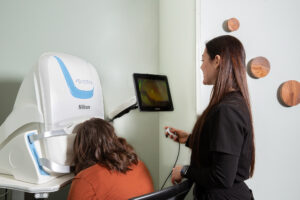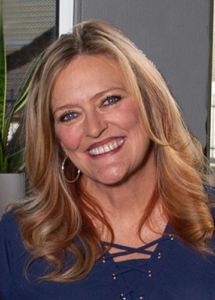
A technician in Dr. Sorrenson’s office capturing a patient’s retinal photo. Dr. Sorrenson says that there are simple actions you can take to increase the number of patients agreeing to these photos.
Laurie Sorrenson, OD, FAAO
April 5, 2023
During my business consultations with other doctors, I always ask two important questions about metrics in their office that can lead to immediate improvements and increased profits. These are my easy-win questions. They relate to two improvements you can make in your practice that will help patients while also building profitability.
The first question is: “Do you know what your retinal image (Optomap, Maestro, etc.) capture rate is? I have found many practices do not measure this metric.
The number 1 rule to get better at something is to know where you are starting from!
First, start measuring this metric on a monthly basis. With most EHRs you can go back and calculate how you have been doing for the last year and use this as your starting point. If the office I am working with tells me that their percentage is above 85 percent, they probably have a really good system in place already and my recommendations might not make much difference.
But if they measure their screening acceptance rate, and it is below 80 percent, I have suggestions that can improve it.
First, the owner and all other practice doctors must believe that screening images are important and necessary every year to do a good eye exam. If the doctor team is not on board with this, and do not believe that annual screening images are necessary, then the capture rate will most likely not reach 90+ percent.
Second, the staff has to believe the same thing. One thing I like to do is send practice teams this video to emphasize the importance of capturing retinal photos: https://youtu.be/okjgMtOTmBo
I send this video to my staff every six months or so to make sure they understand WHY we want to do the retinal image screening every year.
Secondly, the retinal image screening needs to be presented as part of the exam. We should tell the patient before arrival about the additional fee. In my practice, we include that information in the automatic e-mail and text they get when they first make their appointment and in the e-mail/text they receive the day before their appointment. We also provide a quote sheet to all patients upon arrival in the office. This quote sheet has the fee for the Optomap and all the information about what their vision plan and medical insurance covers with co-pays, deductibles, etc.
Other Articles to Explore
Starting a quote sheet can take effort to implement. Fortunately, there are other systems of presenting patients with quotes for their visits that can work just as well. Create a few laminated copies about the retinal screening. State that it is recommended (or required) on an annual basis. Also include on this laminated sheet what the fee is and why it’s important that it be done on an annual basis. I recommend that you quote the fee again at the bottom of the page. You can also add that if they cannot afford the fee, to let the technician know and it can be waived.
Doctors invest significant money in retinal screening technology. Having a high acceptance rate is important for the profitability of the practice, but, more importantly, capturing these images provides better care for your patients.
Next week I will tell you my second favorite “low-hanging fruit.”
 Laurie Sorrenson, OD, FAAO, is president of Lakeline Vision Source in Cedar Park, Texas, and the Professional Editor of Review of Optometric Business (ROB). To contact her: lsorrenson@gmail.com.
Laurie Sorrenson, OD, FAAO, is president of Lakeline Vision Source in Cedar Park, Texas, and the Professional Editor of Review of Optometric Business (ROB). To contact her: lsorrenson@gmail.com.



























